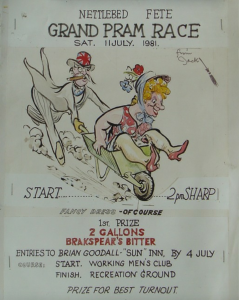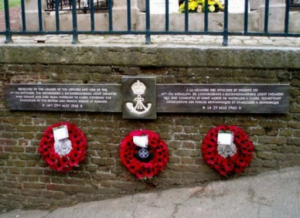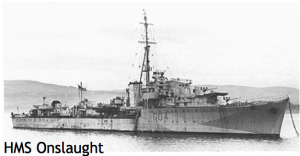On the 70th Anniversary of the ending of World War Two we remember those who served and those who gave their lives in the defence of our nation. The men from Nettlebed who died are recorded on the village war memorial at St Bartholomew’s Church lych-gate and their names are read at Nettlebed’s Royal British Legion Annual Remembrance Service every November.
Where the service records of particular individuals are known it is important that these are recorded on the Nettlebed website’s history page. We would be pleased to add the wartime careers of others if the details could be sent to the editor@nettlebed.org
****************************
 Captain John (Jack) Egerton Broome DSC RN 23.02.1901 – 19.04.1985
Captain John (Jack) Egerton Broome DSC RN 23.02.1901 – 19.04.1985
A destroyer captain who defended convoys with vital supplies for Britain and Russia during the long Battle of the Atlantic and later commanded an aircraft carrier in the Pacific. Jack Broome served in the Royal Navy in both World Wars. He entered the Royal Naval College at Osborne. Isle of Wight, in 1912. As a midshipman his first ship in 1917 was the battleship Colossus in the Grand Fleet.
After attending Trinity Hall, Cambridge in 1923 he chose to serve in submarines for fifteen years operating mainly out of Hong Kong. At the outbreak of war in 1939 he was considered to be too old to command a submarine and he became a destroyer captain. As commander of the First Escort Group (EG1) in the destroyer Keppel during 1941 and 1942 the Escort Group was constantly engaged in arduous convoy duties in the North Atlantic. He was awarded the Distinguished Service Cross in recognition of his untiring work with these convoys.
In June 1942 Broome was assigned as close escort commander to protect Convoy PQ17 sailing from Iceland to Murmansk in Northern Russia. The convoy also had a main covering force of an aircraft carrier, an American battleship and both British and American cruisers. The convoy made good progress despite heavy air attacks. Back in the Admiralty in London intelligence reports then received indicated that the German battleship Tirpitz and her escorts had left Trondheim in Norway and fears were that PQ17 would come under immediate attack from a major force in the close vicinity. Admiral Dudley Pound, the First Sea Lord, signalled the Commander in Chief Admiral Tovey at sea, to immediately scatter the convoy. Reluctantly Admiral Tovey acknowledged the order and turned the escort force and, also questionably Broome’s destroyers, westwards to meet the supposed threat and the opportunity of sinking the Tirpitz. However shortly after receiving the instruction it was realised that the intelligence was incorrect and in fact Tirpitz and the Scharnhorst had moved north to a more secure anchorage at Alten Fjord, Hitler having forbidden his ships to engage a carrier force. By now it was too late to reform the convoy and although a few smaller RN vessels tried to maintain contact, enemy U-Boats and bombers took the opportunity to pick off the scattered merchantmen now sailing on their own. Twenty three out of a total of thirty four merchant ships with their vital supplies were sunk – only eleven arriving in Murmansk.
The Royal Navy suffered heavy criticism for the disaster. Later Jack Broome asked the then First Sea Lord, Admiral Alexander, how the errors came about and why the Commander in Chief, Admiral Tovey had not been allowed to verify the intelligence and then make the decision as to whether to scatter the convoy, but received no satisfactory answer. It was undoubtedly a case wheretactical decisions should have been left to the commander on the spot.
Jack commanded the escort aircraft carrier Begum fighting the Japanese in the Pacific during 1942-44. In 1945 he was put in command of the aged battleship Ramillies, then an accommodation ship at Portsmouth. Like Jack, she began her naval career in the Grand Fleet in 1917. Appropriately the two “Old Salts” ended their naval careers together. Ramillies was broken up and Jack retired in 1947. One of Ramillies 15” guns is now positioned at the entrance to the Imperial War Museum. Jack Broome was awarded the Arctic Star posthumously in 2013.
Jack was an excellent artist and known in the Service for his humorous cartoons depicting naval life and he wrote several books on naval subjects. After retiring he became the editor of The Sketch, the high society newspaper weekly. He was also involved in various TV programmes and films as a naval advisor including ‘The Cruel Sea’, the story of a convoy escort during the Battle of the Atlantic, starring Jack Hawkins.
He lived with his wife Joan in Gannock Cottage, Digberry Lane, Nettlebed. He took an active part in village life and was an enthusiastic supporter of the village art show and cricket club. He was also a founding member of the Lord’s Taverners, the leading youth cricket and disability sports charity.

Jack Broome’s poster advertising Nettlebed fete 1981
Sources:
Oxford Dictionary of National Biography
Jack Broome’s family papers
The Navy at War 1939-45 Stephen Roskill (Pages 204-209)
Liverpool War Museum – Western Approaches (Battle of the Atlantic) Museum situated in the restored war bunker from which the Battle of the Atlantic was directed 1941-45 www.liverpoolwarmuseum.co.uk
*************************************
Captain Michael Valentine Fleming 25.7.1915 – 1.10.1940
Son of Valentine and Evelyn Fleming of Joyce Grove, Nettlebed, Henley on Thames, Oxon.
Served with the 4th (TA) Battalion Oxfordshire and Buckinghamshire Regiment (Oxf & Bucks Light Infantry) which in 1940 delayed the German advance on Dunkirk allowing others to return to England.
Michael Fleming was Adjutant of the local Territorial Army battalion. At the outbreak of war in 1939 he raised a whole platoon for the Battalion from workers on the Fleming’s Nettlebed estate and the local Henley district, who fought beside him. In 1940 the Battalion formed part of the British Expeditionary Force supporting the French army in an attempt to stem the tide of the German Army sweeping westwards across Belgium into France.
At the end of May 1940 the decision was taken to withdraw British forces from the Continent via Dunkirk and other Channel ports. It was a demanding task to evacuate some four hundred thousand troops from ports under constant attack from German bombers. The 4th Oxf and Bucks LI, 2nd Glosters and Ist Bucks were ordered to defend the perimeter of the Dunkirk area in the towns of Hazebrouck and Cassel whilst troops were embarked on hastily assembled naval, merchant and private craft.
The Terriers fought bravely
 The 4th Oxf & Bucks LI and 2nd Glosters set up defences in the ancient hill top town of Cassel 20 miles from Dunkirk. They withstood fierce German bombardment for three days. The Territorials acquitted themselves bravely with Captain Fleming, although seriously wounded, courageously riding his motor bike around the defensive positions to lift the spirits of his men, now very tired and hungry. Michael was mentioned in despatches on three occasions. On the fourth day the Battalions were ordered to head for the beaches- “every man for himself”. Many of the wounded including Michael were unable to make the journey and were captured, spending the rest of the war in POW camps. Michael died from his wounds in a hospital in Lille inOctober where he is buried. Only two Officers and a handful of men managed to reach home safely by Dunkirk after a desperate walk under the cover of darkness to avoid capture.
The 4th Oxf & Bucks LI and 2nd Glosters set up defences in the ancient hill top town of Cassel 20 miles from Dunkirk. They withstood fierce German bombardment for three days. The Territorials acquitted themselves bravely with Captain Fleming, although seriously wounded, courageously riding his motor bike around the defensive positions to lift the spirits of his men, now very tired and hungry. Michael was mentioned in despatches on three occasions. On the fourth day the Battalions were ordered to head for the beaches- “every man for himself”. Many of the wounded including Michael were unable to make the journey and were captured, spending the rest of the war in POW camps. Michael died from his wounds in a hospital in Lille inOctober where he is buried. Only two Officers and a handful of men managed to reach home safely by Dunkirk after a desperate walk under the cover of darkness to avoid capture.
The “week-end soldiers” of the 4th Oxf & Bucks LI had defended Cassel to the last man in spite of not having been battle trained and equipped with Bren guns, the essential weapon of the modern infantryman. The selfless actions of those men at Cassel and Hazebrouck were vital, together with many of the delaying actions which enabled 338,000 men to return to the UK. The 1st Bucks and 4th Oxf & Bucks and 2nd Glosters received a rare compliment from the enemy in a German broadcast on 2 June:
“…..the defenders of Hazebrouck and Cassel not only delayed the advance but resisted in a manner truly worthy of the highest traditions of the British Army. We must recognise that the British fighters were magnificent. We must assume these were their crack Regiments. Each soldier was of marvellous physique and full of fighting spirit. Our soldiers had to storm each house separately”
Michael Fleming lived at Soundess House, Nettlebed, for some years and also in Woodcote. He left a widow Letitia and four children. After Michael’s death they lived at Merrimoles, Highmoor with Peter Fleming, Michael’s elder brother and his wife Celia Johnson the actress. Celia wrote a poem in Michael’s memory:
Now scattered on the thorn their hearts glow red,
Soon the briars of a conquered earth Prodigal lie our English dead.
Gently the petals of that gallant flower Do their fierce crimson centres hide,
And young men, stilled, have gleaming left A heritage of pride.

On 20 May 2006, sixty-six years later after Dunkirk, a regimental Memorial to the Battalion was unveiled and dedicated in a moving ceremony in the Town Hall Square, Cassel.
“Dedicated to the memory of the Officers and Men of the 4th (TA) Battalion, Oxfordshire and Buckinghamshire Light Infantry, who fought and died from Waterloo to Cassel covering the evacuation of British and French forces at Dunkirk. 14th-29th May 1940.”
Sources: –
History of the Oxfordshire and Buckinghamshire Light Infantry (In preparation) ISBN 0-9549370-2-3- Colonel George Elliott (retd), Oxfordshire and Buckinghamshire Light Infantry and Royal Green Jackets.
Nettlebed history files.
Soldiers of Oxfordshire Museum, Park Street, Woodstock, Oxon OX20 1SN, 01993 810210 http://www.sofo.org.uk
Royal Green Jackets (Rifles) Museum, Peninsular Barracks, Romsey Road, Winchester, SO23 8TS www.rgimuseum.co.uk
Read also article Old Camp Road about the Oxf & Bucks Regiment


The hill at Cassel defended by the 4th Battalion Oxf and Bucks Ox & Bucks LI badge
*************************
 Captain Martin Spencer Ollivant DSC MBE R.N. 10.07.1922-31.07.2001
Captain Martin Spencer Ollivant DSC MBE R.N. 10.07.1922-31.07.2001
Son of the late Edward and Olive Ollivant of Walnut Cottage, Lambs Hill, Nettlebed, Oxon.A career naval officer who defended vital convoys in the Mediterranean, the North Atlantic and Arctic Oceans in WW2 and also took part in the Korean War (1950-53).
Martin joined the Royal Navy as a cadet in 1941. He served in destroyers and cruisers in 1941-2 escorting vital convoys in the Mediterranean for the relief of the besieged Island of Malta. His ships took part in both the Battles of Sirte off the coast of North Africa. (These actions are featured in C.S Forester’s novel “The Ship” pub. Penguin Books 1943)
As Lieutenant he served in the destroyer Onslaught in 1943-45 which escorted many convoys to Murmansk in North Russia. In December 1943 his convoy was attacked by the German battleship Scharnhorst. During this action the Scharnhorst was sunk by the British battleship HMS Duke of York that was shadowing the convoy and successfully lured the German capital ship into a trap. This action is known as the Battle of the North Cape.
Martin received the Distinguished Service Cross for his outstanding courage and determination in the face of the enemy whilst escorting the convoys in the exceptionally hard Arctic winter conditions. In 2013 he was posthumously awarded the newly created and much belated Arctic Star Medal along with many other veterans (including the Merchant Navy and RAF aircrews) who served within the Arctic Circle in World War Two.
“The Battle of the Atlantic was the dominating factor all through the war. Never for one moment could we forget that everything happening elsewhere……depended ultimately on its outcome.” W.S. Churchill, ‘The Second World War’. Vol. V. P.6 (Cassel 1952)

In May 1944 his ship Onslaught took part in the D-Day invasion of Europe escorting the landing craft and bombarding the beach defences as well as providing a defensive screen against German submarine and torpedo boat attacks.
In 1952 Martin was appointed to the destroyer Cossack, leader of the 8th Destroyer Squadron, as Squadron Navigator. Cossack took part in the Battle of Pusan Perimeter in the Korean War. Martin was awarded the MBE (Military Division) for his services in Korea. Martin was a specialist navigator and was Deputy Director of Navigation and Direction at the Admiralty 1961-63. As Captain of the South Atlantic patrol vessel HMS Protector in 1963-65 he made a major contribution to the British Government’s Antarctic Survey. The most western point on Saunders Island 57046’S 26031W, part of the South Sandwich Islands, is now named Ollivant Point and ensures his place in Antarctic history.
He was Captain of HMS Dryad, the RN Navigation and Direction School, Portsmouth, in 1965-67. Martin’s last seagoing appointment was in command of the Helicopter Carrier HMS Albion. The carrier was part of the RN task force covering the British withdrawal from Aden in 1967. He was appointed ADC to the Queen in 1969.
On retiring from the Navy in 1970 he lived in the family home in Nettlebed with his wife Mary and sons James and Andrew and daughter Anne. Martin took a very active part in village life particularly with organising the annual art show. He was a Parish Councillor and Council Chairman 1998 – 2000.
Sources:-
http://www.unithistories.com
http://www.navylistresearch.co.uk
Wikipedia – Ollivant Point,
Ollivant family archive